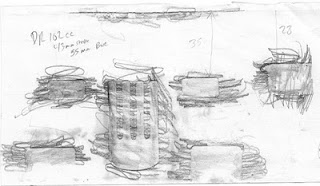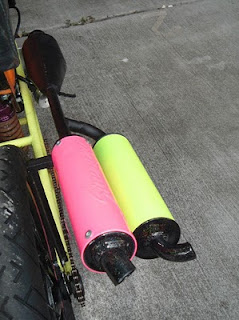I heard that Toyota spends over a million dollars a day on research and development. If you're a enormous company like Toyota, having an robust R&D department allows your company to compete in an increasingly technologically sophisticated market. But, 'research and development' is a nice way of saying repetitive failure. I will remind myself that I am engaged in 'research and development' and remember how far I've progressed in making things. Over a month ago I was busy cracking the combination of heat and time necessary to produce the plastic flywheel covers. A modification to the rig had eliminated the wrinkles that were plaguing the process.
The picture at right is a bunch of the 'almost good enough's' that were fully formed but flawed in one way or another. Since the whole point of this is to make your bike look cooler, having a part with a distracting flaw simply won't do. The biggest problem, is getting the plastic to remove cleanly off the rig. Right now the mechanism that is supposed to eject parts, mostly just breaks them. Also, the hotter the plastic, the more detail it picks up, but this causes bubble to form -so that's the other problem. I haven't worked on this in awhile because I got a gig with
OMSI, a gig that has recently concluded.
While at OMSI, after a brief conversation, one of the exhibit guys I worked with gave me his bottles of
Smooth-On 300 casting resin. 'Since I don't need them.' This fired up my interest in my old cylinder casting schemes. If you've been on the Moped Army Buy/Sell forum, you may have noticed
my attempts to collect suitable specimens for this project.
Mopeds have no shortage of diversity, there are a billion types out there. But only a select group take center stage: Puch/Tomos, Peugeot, Honda Hobbit, Derbi, and to a lesser extent Vespa, Mobylette and Minarelli. If you choose a rare bike, after all the effort of restoration, rebuilding and maintenance, you still only have a bike that goes 25mph, and will likely be at the pack of the pack in a ride, or struggle to climb hills. So, if I'm going to dinker around with cylinder production, I'd like to do so in a way that encourages diversity in the "scene." Some people (Aaron, Joeped, Nate) are f**kin radical enough to offer up their old cylinders to be apart of this mutant rebellion, others I had to buy. But within a relatively brief time, I've collected -or have en route a stable of barrels ready for cloning.
Last night I went with Liz to pick up the Garelli NOI cylinder from Nate. As we we're talking I realized that my explanation of the 'cloning' process doesn't make any conversational sense. So, for anyone interested, I drew up a sketch to illustrate this phase of the process. *also- anyone who has experience with this (Jan Thiel, I'm looking at you) let me know what I'm doing wrong.
First off, know that the objective is to create an accurate wax copy of the cylinder, with the important exception of the port layout, transfers and exhaust. -we eject the stock stuff. But again- a wax cylinder is what we want.
1. If you were to fill all the space
inside a cylinder with say, silicone; it would create a copy of the ports, transfers, the bore itself, etc.. If you pulled that silicone out of the cylinder, you would have a 'negative' of that cylinder. - A
20hp Malossi MHR scooter jug in this case. Thats what #1 is here in the drawing.
2. Take the negative (#1) and then coat it with wax, and keep building up the wax around it, filling in all the nooks and crannies, giving it some thickness. Then remove #1 and what you've got left is a wax copy of the internals of the original cylinder. Not a negative but a copy. This part (#2) is the insert.
3. This is actually a two-part step here. The blocks pictured are a mold of one of the cylinders we're cloning, a Jawa 207, for example. Presuming we've already made that mold, we take the empty mold and plug the insert (#2) into the mold (#3) Close the mold together and fill it with wax. Obviously, we'll make sure the wax doesn't fill the cylinder, just around it.
When you pull the mold apart, you should have a clone of a Jawa 207 cylinder with Malossi MHR internals. This explanation is an over-simplification, but shows the process. There are lots of adjustments that have to be made to account for stroke, crown height, rod length, etc.. differences. You might have noticed that the Vespa and Derbi cylinders above both have a "registration" (highlighted) cut in the bore. After a mold is made from these cylinders, this insures the wax insert stays centered in the mold during the wax filling portion.
As mentioned before, I'm sure there will be plenty of trial and error on the way. (like
Smooth-On 300, not so good actually) Because of these difficulties, and because my money is limited, -who are we kidding - my attention span is too, I hope you'll vote in the poll on the sidebar, to prioritize my efforts.


















































